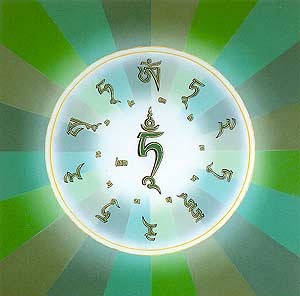The Path
Vajrayana Buddhism
[ Your Text Here ]
[ Your Text Here ]
BODHICITTA
Source; Wikipedia
The Six Perfections of the Bodhisattva
The Six Perfections are: 1] generosity, 2] ethics, 3] patience, 4] effort, 5] concentration, and 6] wisdom.
1
The Six Perfections are: 1] generosity, 2] ethics, 3] patience, 4] effort, 5] concentration, and 6] wisdom.
1
The Ten Bhumis to Buddhahood
The Foundation: Beings in samsara [the six realms] having generated the aspiration to climb the Bodhisattva Bhumis by practicing the six paramitas.
The ten bhumis are described as such:
1." The Joyous " : Having tasted shunyata [emptiness] , we are joyous. Here, the main practice is to perfect the Generosity Paramita. You might be born as a King in the Human Realm and have lots of chances to practice generosity! Now on the Path of Seeing, we can start the Path of Meditation.
2. "The Stainless" : At this bhumi, the main practice is the perfection of Shila [discipline of vows] because of which you are free of anxiety and the 3 Poisons [negative tendencies, obscurations]. You might be born as a chakravartin (King bearing the noble marks of an emperor, like Siddartha Gautama Shakya), whose power and enjoyment are challenged by the practice of discipline and precept-keeping.
3. "The Luminous" : Here, we try to perfect Patience or equanimity. This is the source of the luminosity. You might be born as Indra, King of gods, who is called Shakra, – opposer of the Ashuras.
4. "The Radiant" : After the 3rd Bhumi, the Nirmanakaya aspect of Buddhahood has been perfected. But there are two more kayas, therefore, the Paramita to perfect here is that of Exertion. This activity in the service of virtue creates a radiance of wisdom which burns away false conceptions. Here, you might be reborn as Shyama, a deity in the "Continuous Peaceful Realm").
5. "The Unconquerable" : Driven by exertion, you perfect
dhyana [meditation] and other skillful means in preparation for the helping of all sentient beings. The word unconquerable refers to both the difficulty of achieving the state of dhyani and the state of the being having now achieved this goal. Now it is possible to be born as a god in the Tushita Heavens where you can observe the Six Realms and the interplay of dharma s.
6. "The Manifest" : The intense practice of dhyana and other skills enables you to be reborn as a God-king who can manifest miraculous activity. The Paramita of Prajna is to be perfected.
7. "The Gone-Afar" : Having perfected the Six Paramitas, we now possess both wisdom and skill. This is a plateau below which you will not fall, but there is still room for effort.
In the 10 Paramita system, the perfection is that of Skillful Means needed to overcome Mara who provides opportunities for others to act in opposition.
It is said that once the 7th Bhumi is attained, there is a prophecy of the Buddhas concerning your achieving Buddhahood, and will indicate your Buddha-Name and circumstances.
In a former life, Lord Shakyamuni received this prophecy after having presented 4 golden flowers to the Buddha of that eon .
8. "The Immovable" : At the Eighth Bhumi, you can enter Nirvana at the snap of a finger; so Tathagatas come and click you out of it, reminding you of your aspiration and the work still ahead. But they cannot force you to remain, therefore the virtue is that of firmness of Aspiration.
You might be reborn as Brahma, Lord of the Universe.
9. "The Good-Wisdom" : Almost ready for Buddhabood, you practice the acquisition of the Ten Powers and Six Supernatural Powers. You might also be reborn as Brahma.
10. "The Dharma-Cloud" : All the Buddhas and Bodhisattvas rejoice in your elation at having attained Buddhahood completely. Primordial awareness [ dhyani/jnana ] clears away whatever subtle defilements and tendencies might still be retained. You, like Lord Maitreya in the Tushita Heavens, await your turn. This is also the beginning of the Path of Non-Meditation.
Finally, Buddhahood.
The Foundation: Beings in samsara [the six realms] having generated the aspiration to climb the Bodhisattva Bhumis by practicing the six paramitas.
The ten bhumis are described as such:
1." The Joyous " : Having tasted shunyata [emptiness] , we are joyous. Here, the main practice is to perfect the Generosity Paramita. You might be born as a King in the Human Realm and have lots of chances to practice generosity! Now on the Path of Seeing, we can start the Path of Meditation.
2. "The Stainless" : At this bhumi, the main practice is the perfection of Shila [discipline of vows] because of which you are free of anxiety and the 3 Poisons [negative tendencies, obscurations]. You might be born as a chakravartin (King bearing the noble marks of an emperor, like Siddartha Gautama Shakya), whose power and enjoyment are challenged by the practice of discipline and precept-keeping.
3. "The Luminous" : Here, we try to perfect Patience or equanimity. This is the source of the luminosity. You might be born as Indra, King of gods, who is called Shakra, – opposer of the Ashuras.
4. "The Radiant" : After the 3rd Bhumi, the Nirmanakaya aspect of Buddhahood has been perfected. But there are two more kayas, therefore, the Paramita to perfect here is that of Exertion. This activity in the service of virtue creates a radiance of wisdom which burns away false conceptions. Here, you might be reborn as Shyama, a deity in the "Continuous Peaceful Realm").
5. "The Unconquerable" : Driven by exertion, you perfect
dhyana [meditation] and other skillful means in preparation for the helping of all sentient beings. The word unconquerable refers to both the difficulty of achieving the state of dhyani and the state of the being having now achieved this goal. Now it is possible to be born as a god in the Tushita Heavens where you can observe the Six Realms and the interplay of dharma s.
6. "The Manifest" : The intense practice of dhyana and other skills enables you to be reborn as a God-king who can manifest miraculous activity. The Paramita of Prajna is to be perfected.
7. "The Gone-Afar" : Having perfected the Six Paramitas, we now possess both wisdom and skill. This is a plateau below which you will not fall, but there is still room for effort.
In the 10 Paramita system, the perfection is that of Skillful Means needed to overcome Mara who provides opportunities for others to act in opposition.
It is said that once the 7th Bhumi is attained, there is a prophecy of the Buddhas concerning your achieving Buddhahood, and will indicate your Buddha-Name and circumstances.
In a former life, Lord Shakyamuni received this prophecy after having presented 4 golden flowers to the Buddha of that eon .
8. "The Immovable" : At the Eighth Bhumi, you can enter Nirvana at the snap of a finger; so Tathagatas come and click you out of it, reminding you of your aspiration and the work still ahead. But they cannot force you to remain, therefore the virtue is that of firmness of Aspiration.
You might be reborn as Brahma, Lord of the Universe.
9. "The Good-Wisdom" : Almost ready for Buddhabood, you practice the acquisition of the Ten Powers and Six Supernatural Powers. You might also be reborn as Brahma.
10. "The Dharma-Cloud" : All the Buddhas and Bodhisattvas rejoice in your elation at having attained Buddhahood completely. Primordial awareness [ dhyani/jnana ] clears away whatever subtle defilements and tendencies might still be retained. You, like Lord Maitreya in the Tushita Heavens, await your turn. This is also the beginning of the Path of Non-Meditation.
Finally, Buddhahood.
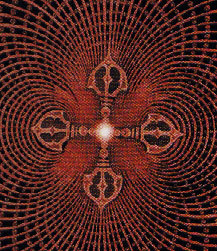
"By this merit, may all attain omniscience. From the stormy waves of birth, old age, sickness and death; may I free all beings."
The dedication of merit is considered one of the most important aspects in Buddhism and is akin to the vital essence of Bodhicitta in terms of its roots in compassion. For any practice to be successful, dedicating the merit for the sake of all beings will assure success in the practice.
Throughout every Vajrayana Buddhist practice, if one has clearly engendered genuine bodhicitta through prayer, offerings, rituals or even simple every day acts of kindness, one receives vast amounts of merit which purifies karma's. As a Bodhisattva who has committed to traverse the path of samsara to benefit beings until time has lost its meaning, the merit which arises through compassionate action is vast and far-reaching and must be given away immediately- for others to benefit from.
The practice of dedicating merit is two fold. Our prayers benefit others lives in myriad ways and our minds always remain firm in our dedication to the dissolution of suffering in samsara, as well as other realms, to bring all beings to the luminous state of liberation.
The dedication of merit is considered one of the most important aspects in Buddhism and is akin to the vital essence of Bodhicitta in terms of its roots in compassion. For any practice to be successful, dedicating the merit for the sake of all beings will assure success in the practice.
Throughout every Vajrayana Buddhist practice, if one has clearly engendered genuine bodhicitta through prayer, offerings, rituals or even simple every day acts of kindness, one receives vast amounts of merit which purifies karma's. As a Bodhisattva who has committed to traverse the path of samsara to benefit beings until time has lost its meaning, the merit which arises through compassionate action is vast and far-reaching and must be given away immediately- for others to benefit from.
The practice of dedicating merit is two fold. Our prayers benefit others lives in myriad ways and our minds always remain firm in our dedication to the dissolution of suffering in samsara, as well as other realms, to bring all beings to the luminous state of liberation.
REFUGE
The importance of refuge and its benefits are the core of the Buddhist path. Once one has taken refuge in the three jewels (mahayana) or the three roots (Vajrayana), the student becomes a vessel for the teachings to be poured into them by a qualified teacher, the Lama (teacher)- the first source of refuge and the most critical to enter into Vajrayana.
The second source of refuge is the Yidam, or, protector. The function of the yidam is to protect the initiate from harmful and obscuring obstacles that may arise on the path as they tread towards enlightenment. A yidam is generally given by ones teacher and is used as a practice throughout one's life.
The Dakini is the third source of refuge and represents the activity of the enlightened mind of the Exalted Ones. She emerges from the luminous nature of liberation to protect the genuine dharma and assist beings in their path to awakening.
The importance of refuge and its benefits are the core of the Buddhist path. Once one has taken refuge in the three jewels (mahayana) or the three roots (Vajrayana), the student becomes a vessel for the teachings to be poured into them by a qualified teacher, the Lama (teacher)- the first source of refuge and the most critical to enter into Vajrayana.
The second source of refuge is the Yidam, or, protector. The function of the yidam is to protect the initiate from harmful and obscuring obstacles that may arise on the path as they tread towards enlightenment. A yidam is generally given by ones teacher and is used as a practice throughout one's life.
The Dakini is the third source of refuge and represents the activity of the enlightened mind of the Exalted Ones. She emerges from the luminous nature of liberation to protect the genuine dharma and assist beings in their path to awakening.
VAJRAYANA -
(The thunderbolt
vehicle) is the Buddhist view that incorporates tantric methods of pure vision or sacred outlook. The
means of exercises, practices and rituals are handed down directly from
teacher to student by word of mouth, though often with the aid of teaching
materials in the form of Buddhist scriptures.
Even though Buddha Shakyamuni rejected the notion of a permanent Self, he acknowledged the belief in rebirth. He said that in samsara, rebirth is inevitable and he taught the methods that he, himself, had used to achieve enlightenment to be released from the bonds of the wheel of rebirth (samsara) in a single lifetime.
Vajrayana works to transmute one's "imperfections" and ordinary awareness by means of un-ordinary and also, some extraordinary methods. The role of the teacher, or vajra master, is critical for transmission in Vajrayana.
Even though Buddha Shakyamuni rejected the notion of a permanent Self, he acknowledged the belief in rebirth. He said that in samsara, rebirth is inevitable and he taught the methods that he, himself, had used to achieve enlightenment to be released from the bonds of the wheel of rebirth (samsara) in a single lifetime.
Vajrayana works to transmute one's "imperfections" and ordinary awareness by means of un-ordinary and also, some extraordinary methods. The role of the teacher, or vajra master, is critical for transmission in Vajrayana.
This
Sanskrit word is a combination of the words bodhi and citta. Bodhi means
"awakening" or "enlightenment". Citta is derived
from the Sanskrit root cit, and denotes "that which is
conscious" – mind or consciousness.
Bodhicitta may be translated as "awakening mind" or "thought of enlightenment".
Bodhicitta may also be defined as the union of compassion and wisdom. This is the development of luminous mind in Buddhism. While the compassion and wisdom aspects of bodhicitta are actually highly dependent on each other, in the Mahāyanā tradition they are often referred to as:
-Relative bodhicitta, in which the practitioner wishes for the good of all beings as if they were their own mothers.
-Absolute, or ultimate, bodhicitta, which refers to the wisdom of shunyata (śunyatā, a Sanskrit term meaning "emptiness"), though the alternatives "openness" or "spaciousness" probably convey the idea better in the English language. The concept of śunyatā in Buddhist thought does not refer simply to nothingness, but to freedom from attachments (particularly attachment to the idea of a self) and fixed ideas about the world and how it should be.
The classic text on śunyatā is the Prajñāpāramitā Sūtra, a discourse of the Buddha commonly referred to as the "Heart Sūtra."
***
Bodhicitta may be viewed as having different levels. In the popular text called Words of My Perfect Teacher by Patrul Rinpoche, he states that the lowest level of bodhicitta is the way of the King, who primarily seeks his own benefit but who recognizes that his benefit depends crucially on that of his kingdom and his subjects. The middle level is the path of the boatman, who ferries his passengers across the river and simultaneously, of course, ferries himself as well. The highest level is that of the shepherd, who makes sure that all his sheep arrive safely ahead of him and places their welfare above his own.
The genuine Vajrayana path can only function through the interdependence of Bodhicitta.
]
Bodhicitta may be translated as "awakening mind" or "thought of enlightenment".
Bodhicitta may also be defined as the union of compassion and wisdom. This is the development of luminous mind in Buddhism. While the compassion and wisdom aspects of bodhicitta are actually highly dependent on each other, in the Mahāyanā tradition they are often referred to as:
-Relative bodhicitta, in which the practitioner wishes for the good of all beings as if they were their own mothers.
-Absolute, or ultimate, bodhicitta, which refers to the wisdom of shunyata (śunyatā, a Sanskrit term meaning "emptiness"), though the alternatives "openness" or "spaciousness" probably convey the idea better in the English language. The concept of śunyatā in Buddhist thought does not refer simply to nothingness, but to freedom from attachments (particularly attachment to the idea of a self) and fixed ideas about the world and how it should be.
The classic text on śunyatā is the Prajñāpāramitā Sūtra, a discourse of the Buddha commonly referred to as the "Heart Sūtra."
***
Bodhicitta may be viewed as having different levels. In the popular text called Words of My Perfect Teacher by Patrul Rinpoche, he states that the lowest level of bodhicitta is the way of the King, who primarily seeks his own benefit but who recognizes that his benefit depends crucially on that of his kingdom and his subjects. The middle level is the path of the boatman, who ferries his passengers across the river and simultaneously, of course, ferries himself as well. The highest level is that of the shepherd, who makes sure that all his sheep arrive safely ahead of him and places their welfare above his own.
The genuine Vajrayana path can only function through the interdependence of Bodhicitta.
]
DEDICATION OF MERIT
His Holiness
the Dalai lama has said;
"Although all phenomena lack any states apart from nominal existence on the conventional level, yet since positive fruits are produced from positive cause, I shall rejoice in the deeds of others."
In the Innermost Essence Preliminary, Jigme Lingpa states;
"If one dedicates merit for the ultimate benefit of others, the virtues will never decrease they will only increase…The exceptional means of dedicating merit is to do so in conjunction with their realization of their own non-reality, without the practice being defiled by any attachment to reality in the merit to be dedicated, in the objects to whom it is being dedicated, and in the purpose for which it is dedicted."
"Although all phenomena lack any states apart from nominal existence on the conventional level, yet since positive fruits are produced from positive cause, I shall rejoice in the deeds of others."
In the Innermost Essence Preliminary, Jigme Lingpa states;
"If one dedicates merit for the ultimate benefit of others, the virtues will never decrease they will only increase…The exceptional means of dedicating merit is to do so in conjunction with their realization of their own non-reality, without the practice being defiled by any attachment to reality in the merit to be dedicated, in the objects to whom it is being dedicated, and in the purpose for which it is dedicted."
May the earth be wholesome everywhere
The world blessed with prosperity
May the poor and destitute find wealth
And the stooping animals be freed
May every being ailing with illness
Find relief at once from suffering
May all the sickness that afflict the living
Be instantly and permanently healed
May those who go in dread, have no more fear,
May captives be unchained and set free,
And may the weak now become strong,
May living beings help each other in kindness.
May travelers upon the road,
Find happiness no matter where they go,
And may they gain, without hardship,
The goals on which their hearts are set.
From the songs of birds and the sighing of trees,
From the shafts of light and from the sky itself,
May living beings, each and every one,
Perceive the constant sound of Dharma
-Shantideva


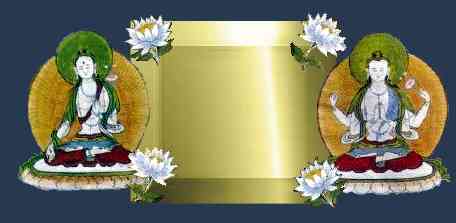
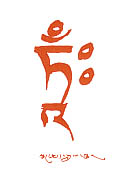
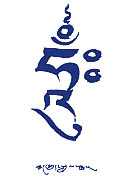
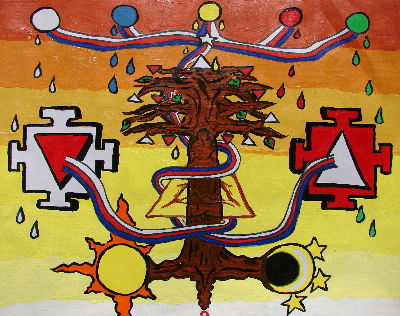
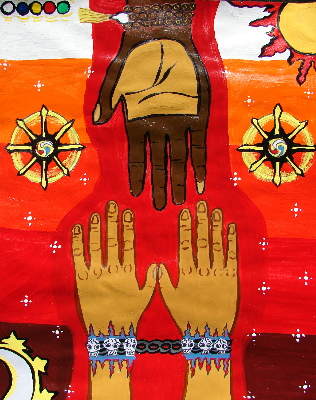
"The practitioner of the Mahayana Buddhist Tantra is a marvelous being - a spiritual warrior par excellence. Unbidden, such a person takes on the responsibility of delivering all sentient beings from samsara, the recurrent cycle of birth-death, rebirth. In order to accomplish this task, the Tantric Bodhisattva dawns the armor of moral, discipline and patience and aquires the laser sharp intellectual sword of Madhyamic reasoning that penetrates to the heart of reality. He carries with him the impenetrable shield of Universal compassion. Riding on the two-winged white steed of Bodhicitta, such a one proceeds to seek out and decapitate the two greatest enemies of those aspiring to the spiritual path - "self grasping" and "self- cherishing".
Avoiding the two extremes of samsara and nirvana, moving swiftly along the wide highway of Mahayana, empowered by the Vajradhara Guru, such a practitioner fearlessly delves into the deepest recesses of the mind in order to find the ultimate wish-fulfilling gem of clear light which is guarded by Yama, the lord of death. Defeating and subduing Yama, the Tantric Bodhisattva uses the gem to attain the highest possible state of existence - Buddhahood - a union of omniscient mind and immortal form. He then proceeds to work ceaselessly, in countless bodies, to deliver all sentient beings over the endless continuum of their lives, strecthing over vast periods of time.
This is not an allegory or a myth but a realistic undertaking. An example of this was Buddha himself who started out as an un-omniscient mortal like the rest of us. Having achieved enlightenment, he taught others how to achieve this state. Since then, many hundreds of thousands of human beings, who have had the good karma to encounter this system , have traversed this path and reached their goal. Many are still in the process of accomplishing it."
- Shri Dharmakirti
Avoiding the two extremes of samsara and nirvana, moving swiftly along the wide highway of Mahayana, empowered by the Vajradhara Guru, such a practitioner fearlessly delves into the deepest recesses of the mind in order to find the ultimate wish-fulfilling gem of clear light which is guarded by Yama, the lord of death. Defeating and subduing Yama, the Tantric Bodhisattva uses the gem to attain the highest possible state of existence - Buddhahood - a union of omniscient mind and immortal form. He then proceeds to work ceaselessly, in countless bodies, to deliver all sentient beings over the endless continuum of their lives, strecthing over vast periods of time.
This is not an allegory or a myth but a realistic undertaking. An example of this was Buddha himself who started out as an un-omniscient mortal like the rest of us. Having achieved enlightenment, he taught others how to achieve this state. Since then, many hundreds of thousands of human beings, who have had the good karma to encounter this system , have traversed this path and reached their goal. Many are still in the process of accomplishing it."
- Shri Dharmakirti




Work in progress
Mahayana Vehicle
Mantra
Source: Wikipedia
Mantras can be interpreted to be effective as vibration, or more
simply as sound, which may include verbal repetition, in the form of chanting,
or internal mental repetition. For this reason great emphasis is put on correct
pronunciation (resulting in an early development of a science of phonetics in India). Mantras
can be used in Eastern spiritual traditions to divert the mind from basic
instinctual desires or material inclinations, by focusing the mind on a
spiritual idea, such as "I am a manifestation of divine
consciousness".
These sounds are manifestations of ultimate reality, in the sense of sound symbolism postulating that the vocal sounds of the mantra have inherent meaning independent of the understanding of the person uttering them. Nevertheless, such understanding of what a mantra may symbolize or how it may function differs throughout the various traditions and also depends on the context in which it is written or sounded. In some instances there are multiple layers of symbolism associated with each sound, many of which are specific to particular schools of thought. For an example of such see the syllable: Aum which is central to both Hindu and Buddhist traditions.
These sounds are manifestations of ultimate reality, in the sense of sound symbolism postulating that the vocal sounds of the mantra have inherent meaning independent of the understanding of the person uttering them. Nevertheless, such understanding of what a mantra may symbolize or how it may function differs throughout the various traditions and also depends on the context in which it is written or sounded. In some instances there are multiple layers of symbolism associated with each sound, many of which are specific to particular schools of thought. For an example of such see the syllable: Aum which is central to both Hindu and Buddhist traditions.
Art by Alex Grey
Work in progress
Under construction


